Adrian Collins's Blog, page 26
March 14, 2025
REVIEW: Bloodchild by Anna Stephens
Darker than black and covered in blood and viscera, Anna Stephens’ Bloodchild is a thundering capstone on her Godblind trilogy. She finishes this merciless, multi-POV, pulls-no-punches series by weaving together cynical banter, intense action, and gut-wrenching heartbreak with a delicate-but-masterful touch.
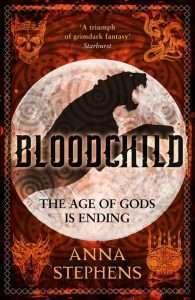 As with the last two books, my favorite character is Crys Tailorson. His transformation from ‘fuck off and let me coast through life’ to ‘I’ll carry this world to salvation myself’ has been nothing short of epic. From homophobe to proud gay man, from malingerer to savior, Crys’ journey is the grimdark version of Sanderson’s Kaladin.
As with the last two books, my favorite character is Crys Tailorson. His transformation from ‘fuck off and let me coast through life’ to ‘I’ll carry this world to salvation myself’ has been nothing short of epic. From homophobe to proud gay man, from malingerer to savior, Crys’ journey is the grimdark version of Sanderson’s Kaladin.
While Crys is my favorite, he had to battle some steep competition. Rillirin, Dom, Tara, and Mace all have strong arguments for being “the stand-out”. You could even throw a curve ball and throw in one of the villains, like Corvus or Lanta. When Stephens penned Bloodchild it’s almost like she was the conduit and the characters spoke for themselves.
You have pregnant characters with agency and action, gay characters living in a homophobic world, sons trying to fill their father’s boots, dark priestesses having sex in blood, an addict battling demonic withdrawal, an assassin waiting to strike (and a host of interesting, complex side characters) who are all living in this blood-soaked, grimdark world, but they never stop trying to make the world a better place. ‘Better’ being, well, extremely subjective, of course.
“And the godlight will lead us all, to death and beyond. And what is beyond death but the promise of new life?”
While the character work is the main attraction of this novel, the action in it is nothing short of breathtaking. I’ve always said that Stover writes the best action in fantasy, but I’ll be damned if Bloodchild doesn’t give him a run for his money. Given Stephens’ approach and the lack of safety for characters (main and side alike) make the stakes of each fight intense. She presents intimate, close range fights—a la Daredevil’s famous ‘hallway fight’—and large scale battles with vivid skill.
The pacing of Bloodchild is just like the other two books in the series: rapid. Featuring an average of two-four pages per chapter, it’s borderline impossible to not speed through it. If I was unemployed or didn’t have a toddler, I’d have climbed in a hammock and read this in a single sitting, and it would have been glorious.
The plot and worldbuilding are mostly great, but they are mired by some inconsistencies and some pacing issues. Bloodchild has a few head-scratching moments where you question whether logical people would act a certain way, and given the surrounding narrative and action, these few shortcomings become exaggeratedly noticeable. On paper these issues are nothing serious and closer to nitpicks than actual errors, but on a canvas as beautiful as Bloodchild, even a few missed brushstrokes stick out.
Quibbles aside, I greatly, greatly enjoyed this novel, and the trilogy as a whole. Godblind had been on my TBR for years and when I finally got to it, I devoured all three books with fervor. Anna Stephens has a new, life-long fan and I’ve called my local library forty times, begging for them to pick up her other work.
If you like grimdarks, quick chapters, blood, and banter, Bloodchild is for you.
Read Bloodchild by Anna StephensThe post REVIEW: Bloodchild by Anna Stephens appeared first on Grimdark Magazine.
March 13, 2025
REVIEW: The M Word by Jeff McIntyre
The M Word by Jeff McIntyre is the follow-up to his debut novel, The Garden Gnome, and the second installment in his Theory of Magic series, which explores the imminent return of magic to our modern world that has long been dominated by science and technology.
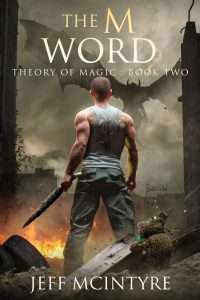 Although The M Word shifts among a wide range of perspectives, the main protagonist of the series is a young boy, Tony Fitzroy. When we first met Tony in The Garden Gnome, he was only ten years old and the target of bullying at his Chicago area school. Tony finds comfort in an enigmatic garden gnome friend known as Burbolbonomicus, or simply Bob for short. While Tony’s parents—history professor Daniel and businesswoman Sophia—believe that Bob is imaginary, the garden gnome proves to be all too real.
Although The M Word shifts among a wide range of perspectives, the main protagonist of the series is a young boy, Tony Fitzroy. When we first met Tony in The Garden Gnome, he was only ten years old and the target of bullying at his Chicago area school. Tony finds comfort in an enigmatic garden gnome friend known as Burbolbonomicus, or simply Bob for short. While Tony’s parents—history professor Daniel and businesswoman Sophia—believe that Bob is imaginary, the garden gnome proves to be all too real.
Jeff McIntyre masterfully blends science fiction into his low fantasy world with a breakthrough physics experiment at Fermilab, the U.S. Department of Energy’s national particle accelerator laboratory located in the outskirts of Chicago. The Fermilab plotline involves several other key characters, including Leo Schafer, a science and technology reporter for the Chicago Tribune, and Deb Kazdin, an FBI field agent with obsessive compulsive disorder. Leo and Deb are investigating Nadir, a group who opposes the experiments at Fermilab and might resort to violence or terrorism to achieve its aims.
In addition to Nadir, The M Word features a shadowy multinational group called Knights of the Stone. Drawing from Arthurian legend, the Knights are committed to suppressing magic by any means necessary. Across the Fermilab, Nadir, and the Knights of the Stone organizations, The M Word shines in its exploration of gray morality and the ethical dilemmas posed by the return of magic. Whereas some people see magic as an opportunity for good, others consider it to be a dire threat that must be stopped at all costs.
McIntyre’s prose is the perfect vehicle for delivering this fast-paced Crichtonesque thriller. I especially enjoyed the blend of fantasy and science fiction, which McIntyre overlays with plenty of personal and political intrigue worthy of a James Bond movie.
On the downside, The M Word suffers from having too many point-of-view characters. This didn’t feel like a problem in The Garden Gnome, but it seems more of an issue with this second book of the series. With so many perspectives, it takes too long to cycle back to the ones I care most about. That being said, the stakes are definitely higher in The M Word, which makes for an especially exhilarating second half of the novel.
Overall, The M Word is a lot of fun and highly recommended for readers looking for a fresh take on scifantasy. Grimdark readers will especially enjoy the story’s multi-layered gray morality and its escalating thrills.
Read The M Word by Jeff McIntyreThe post REVIEW: The M Word by Jeff McIntyre appeared first on Grimdark Magazine.
March 11, 2025
REVIEW: Lucy Undying by Kiersten White
Last Updated on March 13, 2025
If you ever imagined what a gothic, sapphic ‘retelling’ of Bram Stoker’s Dracula could be like, then look no further. Lucy Undying by Kiersten White is a wonderfully gothic, surprisingly emotional, and deliciously dark insight into the eternally brushed-over, ever-tragic character, Lucy Westenra.
 Immortalised by Stoker as Dracula’s first tragic victim, Lucy’s death and rebirth mostly serves as a lesson to showcase the bloody, vivid reality of Dracula’s hunger. Yet, in Lucy Undying, White reclaims and empowers her.
Immortalised by Stoker as Dracula’s first tragic victim, Lucy’s death and rebirth mostly serves as a lesson to showcase the bloody, vivid reality of Dracula’s hunger. Yet, in Lucy Undying, White reclaims and empowers her.
While Lucy is undoubtedly the main protagonist throughout the book, Lucy Undying flits between two characters’ points of view. The first narrative focuses on Lucy and on what happened to her after becoming a vampire, told via excerpts from her diary as she travels from 1890s Whitby across the world up until the modern day.
These entries, filled with female rage, loss, grief and queer longing, neatly intertwine with the narrative of the other main protagonist, Iris. Heir to a ghoulish (quite literally) health empire where “blood is life”, she is desperate to escape her bloodsucking family and reclaim her own path as she moves to London to deal with clearing out her old family estate.
The two women’s stories combine effortlessly, as the two eventually meet when Lucy shows up to help Iris ‘catalogue’ the mansion, uncovering all manner of mysteries about the house and each other. Both are women trying to escape controlling figures and come to terms with their trauma and – as is revealed as the narrative progresses – it turns out that Dracula really does cast a long, horrid shadow.
I think what I liked best as I read this book was the thin sheen of gothic horror that seeped all the way through the narrative. White delightfully chips away at the mystery behind Dracula, leaving you guessing about his fate and lingering, traumatic influence on Lucy at every twist and turn. There are slightly gruesome scenes too, peppered throughout the book. Haunting scenes that include animals, stalking, creaky gothic mansions and Dracula call backs aplenty for those seeking the darker thread in the story.
The slow-burn romance between Lucy and Iris is a nice touch. Not only does she make Lucy become a more fleshed out protagonist, it adds a beautiful twist of hope and melancholy throughout.
While some might scoff at the modern twist on Dracula, and while I thought the latter quarter of the book was a little cliched, focusing more on the sinister US health empire, this was a deliciously dark book I could really sink my teeth into.
If nothing else, this made me want to go back and read Dracula all over again.
Read Lucy Undying by Kiersten White
The post REVIEW: Lucy Undying by Kiersten White appeared first on Grimdark Magazine.
March 10, 2025
REVIEW: Whispers of the Storm by Z. B. Steele
Forget about Kvothe, forget about Vaelin Al Sorna, forget about Gabriel de Léon, Z.B. Steele is here to bring you your new favourite moody, morally grey, and slightly melodramatic bastard telling his legendary life story in Whispers of the Storm. Filled with equal parts bloody action, bittersweet introspection, and soul-stirring emotion, this gritty and gut-wrenching coming of age grimdark military fantasy is a tale for the ages that will blow you off your feet and crush your heart without remorse.  “Ah, Redlin of the Wolves. Vanguard, the Thunderblade, The Justicar’s Revenge, The Reaper in the Winds, The Assassin in Grey. The Storm Itself. It’s a lot of titles for a prisoner.”
“Ah, Redlin of the Wolves. Vanguard, the Thunderblade, The Justicar’s Revenge, The Reaper in the Winds, The Assassin in Grey. The Storm Itself. It’s a lot of titles for a prisoner.”
Now, after falling head over heels in love with Z.B. Steele’s exquisite storytelling in the companion novella An Inkling of Flame, I was beyond eager to dive into this first full length novel in the Song of the Damned series. Yet despite that excitement, I also felt slightly nervous, as Whispers of the Storm follows none other than the enigmatic and hateable villain that I had just become equally terrified and morbidly fascinated by in the novella; talk about bold storytelling, we love to see it.
And I’ll be damned, if I didn’t find myself reluctantly sympathising with and rooting for the notorious monster known as Redlin of the Wolves within just a few pages. After a lifetime of death and destruction, he has finally been captured by the inquisitors and is now being led to the noose, but first the Archon demands his legendary tale to be fully unveiled at last. Will he tell the truth? Who knows, but I sure couldn’t look away from the devastatingly glorious trainwreck that he calls his life story.
“I am a man of many sins, the cause of wars, death, and turmoil. A master of magic and the deadliest man in Usmal with a blade. A Reaper of such scale that the country has never seen.”
So, I can’t sit here and pretend that Whispers of the Storm truly reinvents the wheel in any way, and yet it felt so inexplicably fresh and exciting to me. Sure, the tropes are troping, but they just trope real good. We’ve got a framed narrative, mystical elemental magic that is tied to religion and comes at a high cost, all the best found family and motley crew vibes, and not one, but two military/magical academy settings; what is not to love?!
I had an absolute blast travelling all the way back to Redlin’s childhood to witness the events that shaped him from an innocent little bookworm into the jaded reaper we know in the present. Even though the first half of Whispers of the Storm is quite a slow-burn set-up with relatively low stakes, I found myself utterly hooked by the irresistible air of intrigue, and I quickly became way more invested in all the heartfelt friendships, frustrating rivalries, and little bits of cute puppy love than was probably safe for my emotional well-being (ouch).
“Fighting a war against yourself to try to bury feelings is always a losing battle, but it is one I fought valiantly.”
Still, while I was truly gripped from page one, I think there is no denying that Steele just steps up his game and takes everything to the next level in Part 2. As Redlin enters a new stage of his training, the intriguing world of Usmal organically opens up, and soon the stakes, action and magic just increase exponentially. I really loved the smooth change in setting, and I think it’s a true testament to Steele’s exceptional skill at human storytelling that I latched onto an almost entirely new cast of characters midway through the story with zero problem.
And every time I thought my interest might start to wane, Steele (or Redlin?) managed to pull me back in with a new shocking revelation or a tantalising bit of dramatic foreshadowing that filled me with anticipatory dread. Sure, there might have been some parts that felt a bit meandering or repetitive, but as Redlin says: “You tell your entire life story and see if you don’t repeat yourself. Life is full of repetition. Same paths, same jokes, same fucking mistakes.”
If that didn’t give it away, Redlin is quite a bit of a snarky bastard, and I loved how he infused his raw and intimately vulnerable first person narration with so much surprising heart, emotion and humour. Yes, this is a brutally dark tale of a man at war with himself, and it absolutely doesn’t shy away from exploring some very sensitive topics such as war, faith, loss, regret, mental health, and even sexual trauma from a male’s perspective. But similarly to Jay Kristoff’s Empire of the Vampire or Abercrombie’s First Law series, this book is amusingly self-aware and laced with a sharp, dry gallow’s humour that just had me smiling in grim delight the entire way through.
Be it the sharp banter between young Redlin and his friends, the battle of wits between older Redlin and inquisitor Maya in the expertly executed interludes (possibly my favourite sequences of the story?), or all the little meta-level easter eggs with tuckerizations of some author friends and legendary grimdark characters/authors; it simply shows that Steele had just as much fun writing this story as I had reading it, and his eloquent, evocative and knife-sharp prose just sang to my soul and tugged on my heartstrings in all the most unexpected ways.
“It’s easier to cling to rage than it is to grief. Grief is like a wet cloak that wraps around your body and weighs you down. Rage is like a fire. You may have to burn part of your good nature to keep it burning, but at that time I would have rather burned all my kindness away than continue to mope.”
If An Inkling of Flame hadn’t already given me an inkling (sorry, I am unfortunately not as witty as Redlin) that Steele is a new rising star in grimdark, then Whispers of the Storm completely proved it. This is one of those stories that managed to transport me so fully that I completely lost track of time, and the beautifully bittersweet ending left me hungering for more in the best way possible. If you like your character-driven fantasy gritty, your (anti-)heroes a little broken, and your soul to be shattered, then the Song of the Damned series is simply an absolute must-read.
Thank you to the author for providing me with an eARC in exchange for an honest review. All opinions are my own. Whispers of the Storm is scheduled for release on 25 March, 2025.
The post REVIEW: Whispers of the Storm by Z. B. Steele appeared first on Grimdark Magazine.
March 9, 2025
REVIEW: Solarpunk Short Stories from Many Futures Edited by Francesco Verso
I did not realise that I was in for such a treat from the moment I cracked this one open. Solarpunk Short Stories from Many Futures is an anthology edited by Francesco Verso, and I was so intrigued from the very beginning. The anthology features borderless stories from Argentina, Australia, Brazil, Canada, Czechia, Italy, Spain, the UK and North America. It was refreshing to read from so many diverse voices, including that of Ken Liu, and perspectives focusing on countless ways to navigate the loss of identity, gentrification, and the environmental crises, to name a few. The anthology reminded me of how fiction can pave the way to revolutions and necessary change simply by telling stories.
 Verso’s introduction to Solarpunk was inspiring and uplifting. As someone fairly new to the sub-genre, it was easy to understand its principles and history. Verso outlines when the sub-genre was born, where it was made popular and how it contrasts from both cyberpunk and steampunk. I can safely say now that I am convinced. Solarpunk Short Stories from Many Futures is a remarkable, much-needed anthology in the current state of the world that speaks of a future with renewable energy, de-urbanisation and biomimicry.
Verso’s introduction to Solarpunk was inspiring and uplifting. As someone fairly new to the sub-genre, it was easy to understand its principles and history. Verso outlines when the sub-genre was born, where it was made popular and how it contrasts from both cyberpunk and steampunk. I can safely say now that I am convinced. Solarpunk Short Stories from Many Futures is a remarkable, much-needed anthology in the current state of the world that speaks of a future with renewable energy, de-urbanisation and biomimicry.
Out of the 14 short stories, two resonated with me the most: Ken Liu’s Byzantine Empathy and Renan Bernardo’s Anticipation of Hollowness. Originally published in 2018 and 2021 respectively, I’m thrilled to see them brought together in this anthology!
Byzantine Empathy follows two former college roommates: Tang Jianwen, a jaded programmer who created ‘Empathium’ – a cryptocurrency that drives a new social blockchain, and Sophia Ellis, the Executive Director of an NGO ‘Refugees Without Borders’ – the world’s biggest refugee aid organisation.
The cryptocurrency Emphatium is based on the emphatic reactions of users and thereby determines which humanitarian projects to prioritise. Beneath the technical jargon, the story is a philosophical conversation about the rightful distribution of humanitarian aid. What I enjoyed most about this story was the sheer imaginative reality of it. Liu pits East against West personified by the two main characters, Jianwen and Sophia. Something that I would change about this story is the thick blocks of dialogue at the end, which almost feel a little teaching and felt jarring from the narrative.
The second story that stood out to me, Anticipation of Hollowness, would probably resonate a lot with fans of Ted Chiang’s The Lifecycle of Software Objects – in which they both engage deeply with themes of artificial intelligence and human-AI relationships. Set in the distant future, Anticipation of Hollowness takes place in a seemingly utopian, sustainable city that is heavily gentrified, rendering it inaccessible to lower and middle-class residents. The story follows Janet and her obsolete android companion, Lyria, as they grapple with loss and challenge the deep-seated inequalities lurking beneath the city’s polished facade. Like Chiang’s The Lifecycle of Software Objects, this story is an emotional and thought-provoking one, guaranteed to tug at your heartstrings.
Solarpunk Short Stories from Many Futures outlines the genre seamlessly, and the diverse voices within its pages present provocative worlds, stories and characters ready to fight the world.
Read Solarpunk Short Stories from Many FuturesThe post REVIEW: Solarpunk Short Stories from Many Futures Edited by Francesco Verso appeared first on Grimdark Magazine.
March 8, 2025
7 Music Recommendations to Accompany Your Dark Fiction Journey
Last Updated on March 9, 2025
The foundation of any epic story consists of many complex layers. From strong worldbuilding and complex characters, to visceral battle scenes and smart dialogue, all of these elements build on one another to create unforgettable stories.
This layering of different essential elements can not only be found in writing and storytelling, but also in other forms of art. A prominent one which pairs beautifully with reading a good book is listening to great music.
The lyrics often present the deepest and most personal thoughts of the musicians. Complex layers of instruments such as aggressive guitars, bone-crushing drum beats and ambient synths and keyboard sounds all come together in perfect harmony, creating memorable sounds, which could well become the soundtrack to many grimdark stories.
Not sure where to start your musical journey? I’ve got you covered. Here are seven book and soundtrack pairings for you to elevate your reading experience. Get ready to snuggle down into your favourite reading spot and turn on your speaker.
1. George R.R. Martin: A Song of Ice and Fire Series – Paired with OpethConsidering Martin’s series has been ongoing for two decades, it would only be fitting to recommend listening to the progressive metal band, Opeth. Their early 2000’s offerings gave a great selection of albums such as Blackwater Park, Damnation, and Deliverance. Complex and well written, Opeth’s music matches perfectly to George R.R. Martin`s ASOIAF style. Opeth has over 10 albums, offering you enough music to enjoy with all of the ASOIAF books.

The oldest entry in this list, being released in 1969, but one of my most influential reads! The journey through the Hainish universe must be accompanied by the German band The Ocean. Heliocentric and Anthropocentric are amazing albums which tackle themes such as the human body and mind, and the creation of life and universe.

The first musician/writer on this list, the work of Peter Orullian can be accompanied by the work of Dream Theatre. Orullian has a close connection to the band’s guitarist John Petrucci and keyboardist Jordan Rudess, with the three of them working closely on the novelizations for the albums Metropolis Pt.2, The Astonishing, and Wired for Madness.

The perfect band and album to travel in this amazing grimdark story, is Dimmu Borgir, and the In Sorte Diaboli album. With its medieval theme, tracks such as the Sacrilegious Scorn, The Fundamental Alienation, and The Serpentine Offering will stick with you long after the album is finished.

A more modern sound, great for the amazing story presented in between the stars, Born of Osiris offers complex guitar riffs with excellent melodies. Albums such as Tomorrow We Die Alive and Soul Sphere deliver some of the most technical skills of the band members, perfect to accompany you and Hadrian Harlowe through the stars.
Another amazing progressive metal band to check out, is Between the Buried and Me. They offer an atmospheric experience with the Parallax II album. Tracks such as Extremophile Elite and Lay Your Ghost to Rest are amazing works of art. It feels as if they have been written specifically for Christopher Ruocchio`s work.

Both The Dragon Republic and The Burning God showcase a complex but simultaneously smooth storytelling style. Kuang constantly maintains the reader’s interest and I greatly admire her for it.
A band which certainly pairs perfectly with R.F. Kuang`s writing style is Crystal Lake. Hailing all the way from Japan, they have a smooth, melodic sound, but it is also harsh and aggressive. Crystal Lake will effortlessly accompany you through your journey reading R.F. Kuang`s masterpieces.

It is well known Jay Kristoff is a metalhead at heart, and has spoken in multiple interviews about the love and admiration he holds for bands such as Lamb of God and Bring Me the Horizon.
Lamb of Gods` Ashes of the Wake and Sacrament albums are excellent soundtracks to the events taking place in the Empire of Elidaen.
From Bring Me the Horizon, you should check out the Sempiternal and That’s the Spirit albums. Aggressive, complex, yet filled with melody and strong vocal performances.

In case you have already devoured all those amazing authors from this list, my debut epic fantasy grimdark book, Favors within Ashes, the first book in the Sins of Starlight Collapse series, might hit that same sweet spot for you!
This series starts with a bang! That’s why there is no better album to listen to with it, than Take Me Back to Eden from Sleep Token. This album moves as if in parallel with Favors within Ashes, starting strong, throwing you directly in the heart of it all. Take Me Back to Eden balances heavy, progressive guitars with clean melodic passages in the same way that Favors within Ashes, focuses on character development, alongside the massive world and complex plot present in its 750 pages.

All forms of art should be treasured and shared, but few pair so well as reading and music. I hope you’ve enjoyed these suggestions of soundtracks to accompany your stories and that they stimulate your creative desires and grow your love of both of these arts.
The post 7 Music Recommendations to Accompany Your Dark Fiction Journey appeared first on Grimdark Magazine.
March 7, 2025
REVIEW: The Red Labyrinth by Ben Peek
Two god-like monarchs rule two labyrinthine prisons for the living and the dead beneath the earth, and humanity throw their dissidents and criminals down into the darkness for eternity. But the Red King wants out, to reshape the world above as he has the world below. In The Red Labyrinth, Ben Peek uses the short, sharp storytelling required for great novella writing to deliver a story of population control, service without hope, fear of punishment, of falling into line with the horrible status quo, of hopelessness and of rebellion.

Zoja has learned to read and reproduce books of history she smuggles into her home–a highly illegal act in a society of controlled knowledge. She is careful and wary, looking for knowledge and history and not profit. But she is not careful enough, and finds herself thrown into the darkness and beneath the Red King’s eye.
Zoja’s story is a darkly enjoyable one to follow, and as with all the best modern fantasy, draws upon the society of our day to give you a story that’s relatable and meaningful through a different lens. The living serving the dead feels to me like commentary on the people who work retail and service roles living in inescapable poverty while watching the wealthy move like zombies stuck in the machine around them. The Labyrinths are the traps of our society that it feels impossible to break free of. The Red King and the Black Queen are oligarchs and billionaires violently reshaping the world to their image. The city above the labyrinth is the controls we allow on ourselves. And the rebellion is a message.
I really love how Peek uses the storytelling approach of a third party to the main events describing Zoja’s journey to slowly, and often with an almost off handed comment, reveal more detail of the story while retelling the past. When I opened the book and got stuck in, I wasn’t sure I was going to enjoy this approach, but halfway through The Red Labyrinth I was keeping an eye out for every little crumb of detail Peek’s narrator left me as the world opened up.
The Red Labyrinth has a suitably grimdark ending for my tastes, with a final twist I kind of knew was coming, but found hit really nicely. Peek clearly understands the shorter form approach as its own form of art versus his longer-form novels (The Children Trilogy, starting with The Godless), and I enjoyed the read all the more for it.
The Red Labyrinth is a beautiful novella where the reader can get as deep as you like into the themes, or just enjoy a cracking fantasy story where the downtrodden and discarded fight back.
Read The Red Labyrinth by Ben PeekThe post REVIEW: The Red Labyrinth by Ben Peek appeared first on Grimdark Magazine.
March 6, 2025
REVIEW: Conan the Barbarian #18
Having decided to spare the life of Tarnasha, the foolhardy thief that invaded their bedchamber in Conan the Barbarian #17, Conan and Bêlit allow themselves to be talked into a plan to rob a local antiquarian of a priceless treasure of Stygian origin. Conan has misgivings, as his last encounter with Stygia and its Set-worshipping snake cult was an unsettling one, but he’s swayed by his pirate queen’s talk of riches and her eagerness to pull one over on the hated Stygians. The trio immediately begins plotting a daring heist. Once their hastily assembled plan is put into action, however, bloodshed and betrayal ensue.
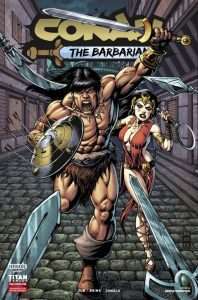 This issue concludes the two-part Fangs and Foolish Thieves storyline. All previous arcs in Titan Comics’ Conan the Barbarian series have run across four issues, so it’s perhaps inevitable that this particular story feels abbreviated. Indeed, the pacing felt rushed the first time I read through this issue, with several elements introduced late into the story and left unresolved. That feeling lessened upon revisiting the issue, however. Tarnasha will doubtless reappear in a subsequent plotline, as will the other dangling threads established herein. The 2025 Free Comic Day Issue of Conan the Barbarian is set to launch an event called Scourge of the Serpent, and a Solomon Kane series entitled The Serpent Ring is scheduled to arrive even before that, so it appears that readers have a decidedly reptilian year ahead of them. Appropriate for the Chinese zodiac’s Year of the Snake.
This issue concludes the two-part Fangs and Foolish Thieves storyline. All previous arcs in Titan Comics’ Conan the Barbarian series have run across four issues, so it’s perhaps inevitable that this particular story feels abbreviated. Indeed, the pacing felt rushed the first time I read through this issue, with several elements introduced late into the story and left unresolved. That feeling lessened upon revisiting the issue, however. Tarnasha will doubtless reappear in a subsequent plotline, as will the other dangling threads established herein. The 2025 Free Comic Day Issue of Conan the Barbarian is set to launch an event called Scourge of the Serpent, and a Solomon Kane series entitled The Serpent Ring is scheduled to arrive even before that, so it appears that readers have a decidedly reptilian year ahead of them. Appropriate for the Chinese zodiac’s Year of the Snake.
Issue #18 includes some entertaining references for knowledgeable Conan fans. The Stygian episode Conan flashes back to in the opening pages is, of course, a nod to the original Robert E. Howard prose story “The God in the Bowl.” The Stygian relic at the heart of the story is unmistakably the same intertwined serpent dagger wielded by James Earl Jones’ villain Thulsa Doom in the 1982 Conan the Barbarian movie. The cinematic Atlantean Sword and Thulsa Doom himself (despite being King Kull’s foe in Howard’s work) have also appeared in previous issues of this comic, demonstrating Jim Zub’s fun willingness to embrace the Conan the Barbarian body of work in all its forms and expressions, rather than limit himself to strict Howard purism.
Judging from online commentary, Danica Brine’s artwork in the previous issue was a point of contention for some readers. While admittedly the art style does feel a tad on the “cute” side for Conan —Tarnasha and her truly outrageous pastel outfit would fit right in with Jem and The Holograms—I’d rather see a variety of representations of these characters than witness Conan the Barbarian stagnate and settle into dead-end “John Buscema Über Alles” conservatism.
While our reunion with Conan and Bêlit is regrettably a brief one, Conan the Barbarian #18 caps off a whirlwind caper. The shorter storyline and fresh artwork show that Jim Zub is still willing to experiment with the Titan Comics series, even as the title sprints towards its second anniversary.
Read Conan the Barbarian #18 by Jim Zub (W) and Danica Brine (A)The post REVIEW: Conan the Barbarian #18 appeared first on Grimdark Magazine.
March 5, 2025
REVIEW: The Once and Future Witches by Alix E. Harrow
As much as I love long fantasy series and adore the trilogies that seem to be the backbone of the fantasy writing world, sometimes I can’t commit to a multibook adventure. Whether it’s a quick but impactful novella or a full-length standalone novel, there is something intensely satisfying in knowing that you are reading a contained singular tale.
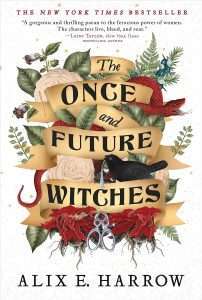 I’m trying to use standalone fiction more to break up my jumps from series to series, and it seems to be working quite well. I’ve been working through the GdM Top 10 List of Standalone fantasy novels and adding others to my TBR list as I go. One name that kept coming up as a recommendation was Hugo Award winning Alix E. Harrow. Team GdM praises her highly, with magazine editor Beth saying, ‘Harrow can do no wrong.’ Harrow’s Southern Gothic Starling House tempted me as my first venture into her writing, I’ve had a copy of her The Once and Future Witches on my shelf for a while, so I picked that up instead.
I’m trying to use standalone fiction more to break up my jumps from series to series, and it seems to be working quite well. I’ve been working through the GdM Top 10 List of Standalone fantasy novels and adding others to my TBR list as I go. One name that kept coming up as a recommendation was Hugo Award winning Alix E. Harrow. Team GdM praises her highly, with magazine editor Beth saying, ‘Harrow can do no wrong.’ Harrow’s Southern Gothic Starling House tempted me as my first venture into her writing, I’ve had a copy of her The Once and Future Witches on my shelf for a while, so I picked that up instead.
What was originally intended as a palate cleanser between reading an eight-book series has become one of my top reads of the year so far. The Once and Future Witches is a very well-written, uncannily relevant story of power and sisterhood.
Set in 1893, The Once and Future Witches takes place in New Salem, a city free from the sin of witchcraft. We follow the three Eastwood sisters reuniting: Beatrice Belladonna, Agnes Amaranth, and James Juniper, who know what it’s like to be powerless and abused. The only power available to women is to rally for their vote; magic and the witches who wielded it have been purged from society and are now nothing but a half-remembered nursery rhyme. But all you need to cast is the words, the will, and the way. Some words survive no matter how many books are burnt. Some wills will not be broken. Witches will always find a way.
When faced with impossibly difficult times, Harrow’s story of hope and strength should appeal to many readers, but the Eastwood sisters make The Once and Future Witches stand out. They are all flawed, rough, and wounded in different ways. They must work out how they fit together as adult sisters after a profoundly cruel childhood and how they can be wilful women in a society that won’t allow it. Their development and growth throughout The Once and Future Witches were the reason I kept reading. I cared deeply for these women and their stories, and considering they are fictional women in a fantasy story, they felt genuine to me. They aren’t the morally grey typical grimdark lead we may expect, but they are far from perfect and are underdogs worth rooting for. The Once and Future Witches’ villain, Gideon Hill, is as disturbing as the Eastwood sisters are endearing. Sadly, a charismatic man who abuses their power is more than a fictional trope, but thankfully, at least Gideon Hill is fictional.
Set in a time most usually associated with industrial changes and the women’s suffrage movement, a story about the return of lost magic does not feel out of place. In The Once and Future Witches, Harrow places lots of historical nuggets to make the story feel more accurate to the reader. The story’s dark elements are also more real than fantastical. For example, there are two traumatic birth scenes, one of which results in maternal mortality. There is a societal stigma around unwed mothers, but even more so around the procurement or provision of abortion. But in a way, this makes the bad things that happen in The Once and Future Witches more impactful. These horrible things do not occur because they are witches; they happen because they are women. There are moments in The Once and Future Witches that ring eerily true in today’s world, even though this is an alternate-history fantasy novel set centuries ago, and that’s quite a disturbing feeling to have.
The Once and Future Witches is an unexpected newfound favourite of mine, and I am glad to have finally read Alix E. Harrow. I loved the tradition associated with her magic system and the complexity of her characters. As with all standalone stories, the ending is a little bittersweet, but that’s also a big part of their charm: this is all you get, even if you would actually quite like there to be some more, please.
I may not be able to read more of this particular story, but I will be picking up Alix E. Harrow again.
Read The Once and Future Witches by Alix E. Harrow
The post REVIEW: The Once and Future Witches by Alix E. Harrow appeared first on Grimdark Magazine.
March 4, 2025
Review: The Underhistory by Kaaron Warren
Last Updated on March 5, 2025
Kaaron Warren brings Gothic horror to a contemporary Australian setting in her latest novel, The Underhistory. The protagonist, Pera Sinclair, was only nine years old when her family’s mansion was destroyed by a plane crash. As the sole survivor, Pera was determined to rebuild her family home as a perfect replica from her childhood, also serving as a monument to everyone who perished inside.
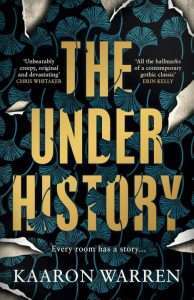 The novel alternates between the World War II-era backstory of the Sinclair family and the modern-day setting of the reconstructed Sinclair House. Present-day Pera has made a living giving tours of her purportedly haunted home. Each room of the Sinclair House has its own quirky name and a unique story to tell, especially the cellar known as the Underhistory.
The novel alternates between the World War II-era backstory of the Sinclair family and the modern-day setting of the reconstructed Sinclair House. Present-day Pera has made a living giving tours of her purportedly haunted home. Each room of the Sinclair House has its own quirky name and a unique story to tell, especially the cellar known as the Underhistory.
Visitors to the Sinclar House are captivated by the mansion’s history of death, and Pera is more than happy to oblige her guests’ desires to hear a good ghost story. Indeed, Pera’s storytelling abilities are one of the highlights of The Underhistory.
But Pera’s final haunted house tour of the season brings a group of suspicious and probably dangerous men. With these unscrupulous men threatening her home, Pera must use her storytelling prowess and some psychological manipulation to remain safe, lest death claim the last remaining member of the Sinclair family.
The Underhistory has a very interesting premise, and Kaaron Warren excels at creating a quirky yet foreboding atmosphere. However, for all the talk of paranormal activity, the horror aspects of the novel never build up to a truly satisfying level of terror. The story also suffers from too many time jumps, which give The Underhistory an overly disjointed feel.
Nevertheless, readers looking for a new twist on the classic haunted house horror will find a lot to love in this casually quirky yet deeply atmospheric novel, which rewards the patient reader with many layers of psychological depth. Kaaron Warren has been one of my favorite horror authors since her brilliant short story collection, Dead Sea Fruit, and I look forward to reading more from her in the future.
Read The Underhistory by Kaaron WarrenThe post Review: The Underhistory by Kaaron Warren appeared first on Grimdark Magazine.

 Read on Amazon
Read on Amazon

